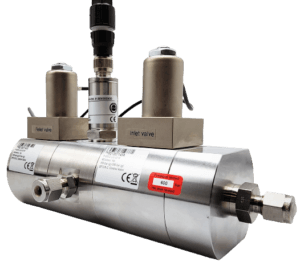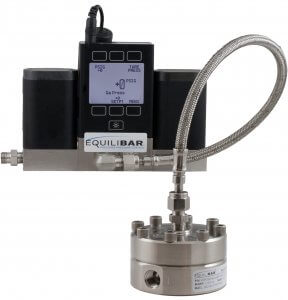If you have an automated process, you are likely to prefer the use of electronic pressure controllers or automated process regulators. Pressure Control Solutions is particularly specialized in this and as a result, we offer a range of electronic pressure controllers, including unique set-ups that we have engineered in-house. We can help you in making the right choice.
Most electronic pressure controllers operate with an analog signal like 0…5(10) Vdc or (0)4 to 20 mA signal. Digital bus communication systems are available on several models as well.
Generally, each electronic pressure controller consists of:
With the use of our electronic reference controllers, you can electronically pilot the reference pressure supplied to the back pressure regulator. Most electronic pressure controllers operate with an analog signal like 0…5(10) Vdc or (0)4 to 20 mA signal. Additionally, digital bus communication like EtherCAT, ProfiNet, Profibus, Modbus, CANopen, etc. is also available on several models.
The valve can be placed upstream or downstream of the sensor, creating either an electronic forward pressure reducing regulator or an electronic back pressure regulator.
The primary distinction is the pressure that you want to maintain at the reference of the back pressure regulator or control valve: If you only need low pressure, and you have machine shop air available, you might be less focused on the consumption of air. For higher pressures, these factors can be more relevant and complex.
PCS offers multiple options that allow the user to keep a close eye on the consumption of pressurized gas. Standard dual valve controllers are available up to 200 bar gauge. These regulators are designed to set the reference pressure with very limited consumption of pressurized gas. A dual valve pressure controller combines an accurately calibrated pressure sensor with a PID controller and 2 proportional valves.
The setpoint can be given in analog or digital manner. The system will compare the measured value with the reference value. If the reference pressure is too low, the upstream valve opens to increase the reference pressure. Is the measured value too high, then the downstream valve will open to decrease. Under normal conditions, when the pressure is stable at the instructed level, both valves will remain closed, thus reducing the flow consumption of the process media to 0.
In cases where consumption is of lesser importance or using two valves is technically not ideal, a single valve controller might be a good alternative: Our single valve controller uses just 1 proportional valve and is construed using a constant bleed.
Not only is this a cost-effective approach, it can also be technically beneficial for certain applications to have only one valve. For example, we can tune this regulator to be in control constantly. Other than a dual valve controller (where both valves will be normally closed), a single valve controller using a constant bleed will be set normally opened. The valve will always be slightly opened being able to control more precisely.



